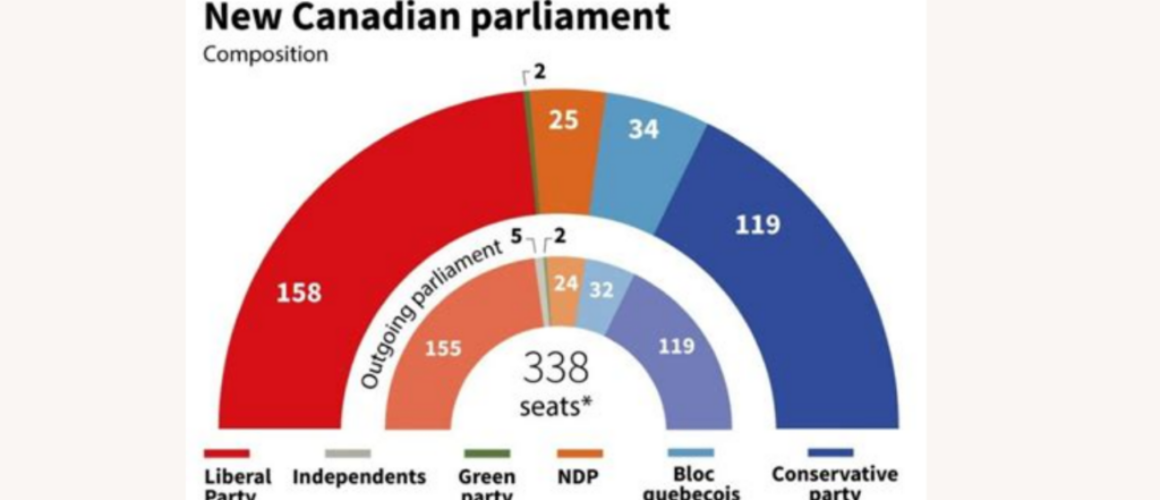Conservative vs. Liberal: Canada’s Great Policy Divide in 2025

Ottawa, ON – The 2025 federal election wasn’t just a political contest—it was an ideological reckoning. The platforms presented by Pierre Poilievre’s Conservative Party and Mark Carney’s Liberals reflected two sharply diverging visions for the future of Canada. While Liberals clinched victory at the ballot box, the deeper implications of these contrasting approaches continue to ripple through public discourse.
This article offers a comprehensive comparison between the two dominant parties on four key fronts: economic strategy, climate policy, healthcare vision, and foreign affairs. The contrasts are not only philosophical—they reflect fundamentally different beliefs about the role of government in Canadian life.
Economic Policy: Austerity vs. Activism
Conservatives under Pierre Poilievre campaigned on promises to:
-
Cut federal spending
-
Eliminate the carbon tax
-
Return to balanced budgets within three years
-
Reduce red tape and promote free enterprise
-
Support cryptocurrency adoption as a decentralization tool
Poilievre argued that Canada’s rising inflation and deficit spending were symptoms of federal overreach, calling for a return to “sound money” and minimal government.
Liberals under Mark Carney, meanwhile, focused on:
-
Expanding infrastructure investment
-
Supporting green technology startups
-
Maintaining selective stimulus to protect economic recovery
-
Introducing new tax credits for child care, seniors, and small businesses
Carney framed the economy as a “long game,” emphasizing that strategic public investment, not austerity, would secure Canada’s global competitiveness.
Key difference: The Conservatives saw the state as a problem; the Liberals saw it as a partner.
Climate Change: Oil vs. Opportunity
The divide between the parties on climate was perhaps the most pronounced.
Poilievre’s Conservatives campaigned on:
-
Repealing the federal carbon tax immediately
-
Expanding pipelines and natural gas exports
-
Opposing federal interference in provincial energy matters
-
Promoting nuclear and hydro over wind and solar
This approach sought to protect resource jobs, particularly in Alberta and Saskatchewan, and reframe energy development as patriotic.
Carney’s Liberals, by contrast, pledged:
-
To maintain and expand carbon pricing mechanisms
-
To hit net-zero by 2050 with firm sector-by-sector targets
-
To invest in electric vehicle infrastructure and battery manufacturing
-
To tie federal funding to climate accountability benchmarks
Carney argued that climate transition wasn’t a cost—it was Canada’s greatest economic opportunity.
Key difference: Conservatives saw climate regulation as economic sabotage; Liberals framed it as market modernization.
Healthcare: Private Efficiency vs. Public Expansion
Healthcare was a surprisingly hot-button issue in 2025, especially with provinces like Ontario and Alberta exploring public-private partnerships.
The Conservative Party proposed:
-
Allowing limited private clinics to reduce wait times
-
Encouraging innovation through competition
-
Giving provinces more autonomy in health spending
The Liberal Party countered with:
-
Federal expansion of mental health services under the Canada Health Act
-
New funding for rural healthcare access
-
Nationwide standards for elder care and long-term facilities
-
Explicit opposition to two-tier healthcare
Public polling showed Canadians largely preferred public control, though Poilievre’s message found some traction among younger urban voters frustrated by system delays.
Key difference: Conservatives prioritized efficiency; Liberals focused on equity.
Foreign Affairs: Assertive Nationalism vs. Strategic Diplomacy
Canada’s role in an increasingly unstable world order also revealed stark party divides.
Conservatives advocated for:
-
A tougher stance on China and Iran
-
Retaliatory tariffs against U.S. steel and aluminum duties
-
Cutting foreign aid in favor of domestic security spending
-
Declaring Canadian Arctic sovereignty non-negotiable
Liberals, in contrast, pushed for:
-
Increased collaboration with NATO, the G7, and the Indo-Pacific alliance
-
Diplomatic de-escalation in U.S.-Canada trade tensions
-
An updated immigration strategy targeting high-skilled labor
-
Climate diplomacy, especially with EU and South Pacific partners
Carney used his international stature to portray the Liberals as globally credible and Canada as a voice of moderation in a volatile West.
Key difference: Conservatives favored nationalism and strength; Liberals sought cooperation and global stature.
The Verdict: Ideology or Adaptation?
The 2025 election showed Canadians favor pragmatic progressivism over ideological rigidity—at least for now. But with cost-of-living anxieties still high and western alienation simmering, the Conservative platform still resonates in many corners of the country.
The real question going forward: will the next Conservative platform evolve to reflect Canada’s centrist tendencies, or will it double down on ideological purity?